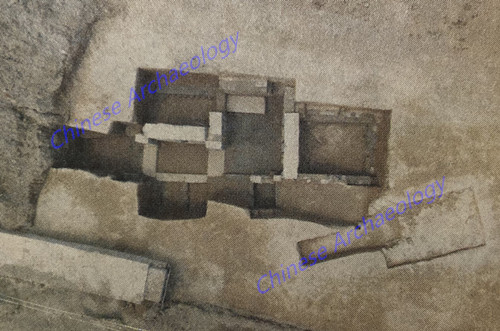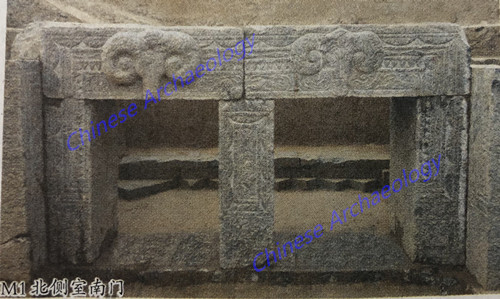Information
Two Tombs with Stone-Relief from Han Dynasty Found in Jinan, Shandong
Summary: Two Tombs with Stone-Relief from Han Dynasty Found in Jinan, ShandongFrom:Chinese ArchaeologyWriter:Date:2017-12-05From July to September 2017, salvage excavation of tombs situated in the north of Yaoshan Hill in Tianqiao District, Jinan, were conducted b
Two Tombs with Stone-Relief from Han Dynasty Found in Jinan, Shandong
From:Chinese Archaeology Writer: Date:2017-12-05
From July to September 2017, salvage excavation of tombs situated in the north of Yaoshan Hill in Tianqiao District, Jinan, were conducted by Jinan Municipal Institute of Archaeology. 3 tombs were cleared in total, including 2 tombs with stone-relief from Han Dynasty and a brick-chamber tomb from Song and Yuan Dynasties. A small number of glazed potteries, iron artifacts and copper coins were unearthed.

Aerial photo of tomb M1 and M2
Tomb M1 was a multi-chamber tomb built by bricks and stones. It had an earthen grave and a tomb passage. It’s irregular in plane, consisting of a tomb passage, a vaulted passage, tomb gate, a front chamber, a middle chamber, a back chamber, 2 side chambers and a side room. The floor was brick-paved. The top was already collapsed. The passage was 2.2m long residue. Between the passage and the door, there was a 1.6m wide vaulted passage connecting them with each other, which was constructed by bricks. The door was made of bluestones. On both sides of the lintel and doorposts, there were carved reliefs. On the door leaves, there were a couple of line-carved ring handle with animal head. Inside the rings, there were a couple of fish. All the chambers were rectangular in plane. The residual tomb walls were all built in monk bond. All rooms were connected by stone doors. 27 pieces of stone reliefs were cleared, including 46 portraits. All subjects from the reliefs can be divided into 3 categories. The first are auspicious animals, mainly having goat heads, dragons, flying birds, tigers, deer, rabbits, horses and other animal figures. The second are geometric designs, ranging from vertical curtain pattern, diamond pattern, triangle pattern, weave pattern and so on. And the last are maids holding dressing case in the hands. The portraits were carved in low relief, high relief or fine line engraving. Most of burial gifts and human skeletons were unearthed from the middle chamber. Vessels from them were heavily destroyed, most of which were green-glazed terra-cotta vessels. Pottery shapes contain cups with two handles on the edge, spoons, plates, pots and so on. Besides, 15 copper coins were found, all badly rotten, with unrecognizable scripts. It was suggested the bad preserved human skeletons were belonged to 3 individuals.

The gate of north chamber in tomb M1
Tomb M3 was situated in the northeast of M1, about 11meters’ away. It was also a multi-chamber tomb constructed by stones and bricks. It had an earthen grave. The plane of the tomb was irregular. It consisted of a tomb passage, a tomb gate, a front chamber, a middle chamber, a back chamber, a side chamber and a small side room along the main chamber. The grave was 11.6m long, 4.5m wide and about 3m high from bottom to opening residue. The passage was a long oblique slope, 11.6m long. Chambers had vertical pits and straight walls. They had relatively flat floors, all paved with bricks in oblique staggering tiling. Most of the top was collapsed. All of the lintel and doorposts had reliefs on one side. 14 stone reliefs were found with 14 portraits. Compared with M1, the style of reliefs discovered from M3 was rough and crude. They were carved in low relief and line carved on the surface. The reliefs depicted two kinds of subjects, auspicious animals and geometric decorated patterns. The former contained goat heads, dragons, tigers, vermilion bird and other animal figures. The latter included vertical curtain pattern, triangle pattern, diamond pattern and weave pattern and etc. Most burial gifts were found in the middle chamber. 24 glazed pottery artifacts could be recovered, ranging from branch lamps, pots, tables, spoons, cups with small handles on the edge, plates and so on. Moreover, there were an iron adze and 17 copper coins. Human skeletons were already heavily rotten, the majority of which were hardened and mingled in silt on tomb bottoms. Only one skull was found.
Tomb M2 was about 0.15m southeast of M1. It was a single-chamber tomb with a rectangular plane. The tomb was in rather bad state of preservation. Walls were relatively straight and bottom was flat with brick-paved floor. Tomb passage was in a rectangular plane, 3.2m long and 1m wide. Tomb chamber was 4m long, 2.4m wide and 0.2m high residue. No burial furniture and burial goods were discovered, only little bone residue were left. Burial practice was unknown. According to the tomb form, it’s preliminarily predicted to belong to Song and Yuan Dynasties.
Although M1 and M3 were partially destroyed, the whole structures were still clear, from which they can be predicted to be multi-chamber tombs with stone and brick structures. Considering their forms, subjects of stone reliefs as well as other unearthed artifacts, it’s predicted that they belong to late period of Eastern Han Dynasty and the tomb owners should be part of middle and lower rank officers or landed class. This excavation provided new materials for research on stone-relief tombs from East Han Dynasty in this area. Now, all the discoveries from the tombs were moved for further protection. (Translator: Ma Huanhuan)

Aerial photo of tomb M1 and M2
Tomb M1 was a multi-chamber tomb built by bricks and stones. It had an earthen grave and a tomb passage. It’s irregular in plane, consisting of a tomb passage, a vaulted passage, tomb gate, a front chamber, a middle chamber, a back chamber, 2 side chambers and a side room. The floor was brick-paved. The top was already collapsed. The passage was 2.2m long residue. Between the passage and the door, there was a 1.6m wide vaulted passage connecting them with each other, which was constructed by bricks. The door was made of bluestones. On both sides of the lintel and doorposts, there were carved reliefs. On the door leaves, there were a couple of line-carved ring handle with animal head. Inside the rings, there were a couple of fish. All the chambers were rectangular in plane. The residual tomb walls were all built in monk bond. All rooms were connected by stone doors. 27 pieces of stone reliefs were cleared, including 46 portraits. All subjects from the reliefs can be divided into 3 categories. The first are auspicious animals, mainly having goat heads, dragons, flying birds, tigers, deer, rabbits, horses and other animal figures. The second are geometric designs, ranging from vertical curtain pattern, diamond pattern, triangle pattern, weave pattern and so on. And the last are maids holding dressing case in the hands. The portraits were carved in low relief, high relief or fine line engraving. Most of burial gifts and human skeletons were unearthed from the middle chamber. Vessels from them were heavily destroyed, most of which were green-glazed terra-cotta vessels. Pottery shapes contain cups with two handles on the edge, spoons, plates, pots and so on. Besides, 15 copper coins were found, all badly rotten, with unrecognizable scripts. It was suggested the bad preserved human skeletons were belonged to 3 individuals.

The gate of north chamber in tomb M1
Tomb M2 was about 0.15m southeast of M1. It was a single-chamber tomb with a rectangular plane. The tomb was in rather bad state of preservation. Walls were relatively straight and bottom was flat with brick-paved floor. Tomb passage was in a rectangular plane, 3.2m long and 1m wide. Tomb chamber was 4m long, 2.4m wide and 0.2m high residue. No burial furniture and burial goods were discovered, only little bone residue were left. Burial practice was unknown. According to the tomb form, it’s preliminarily predicted to belong to Song and Yuan Dynasties.
Although M1 and M3 were partially destroyed, the whole structures were still clear, from which they can be predicted to be multi-chamber tombs with stone and brick structures. Considering their forms, subjects of stone reliefs as well as other unearthed artifacts, it’s predicted that they belong to late period of Eastern Han Dynasty and the tomb owners should be part of middle and lower rank officers or landed class. This excavation provided new materials for research on stone-relief tombs from East Han Dynasty in this area. Now, all the discoveries from the tombs were moved for further protection. (Translator: Ma Huanhuan)
Category: English
News
Information
Key words:
